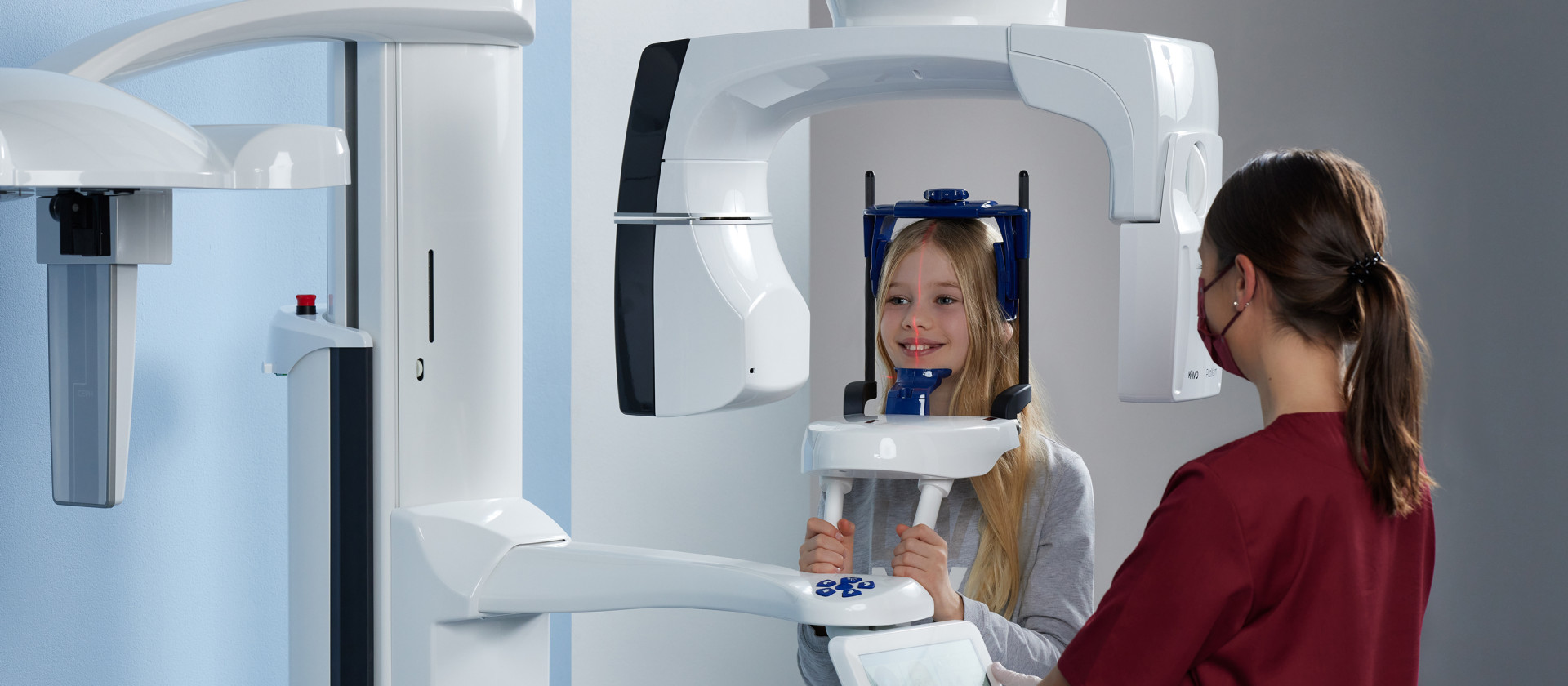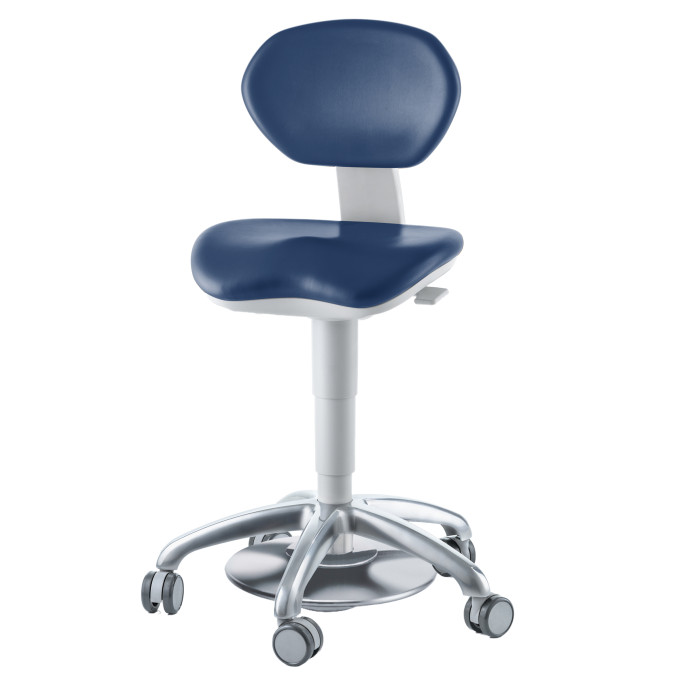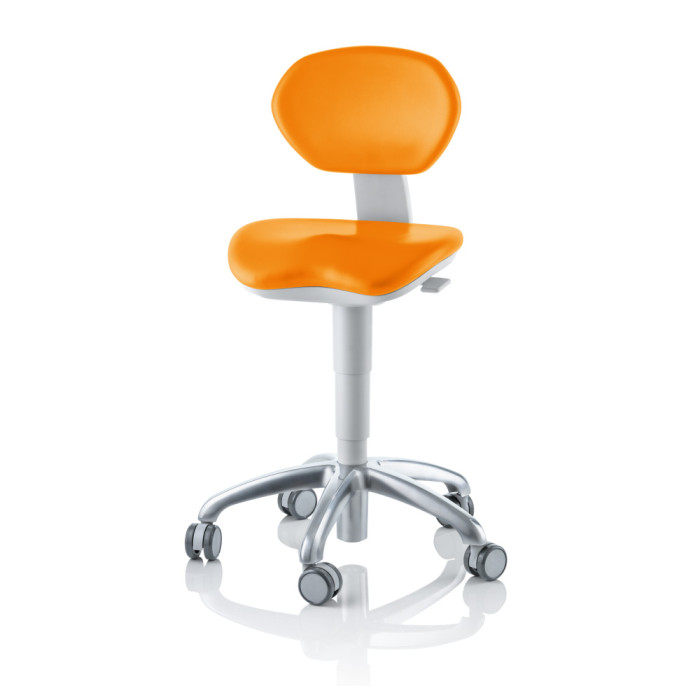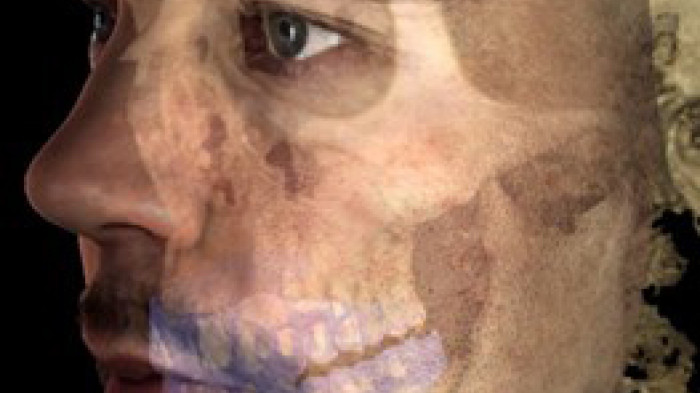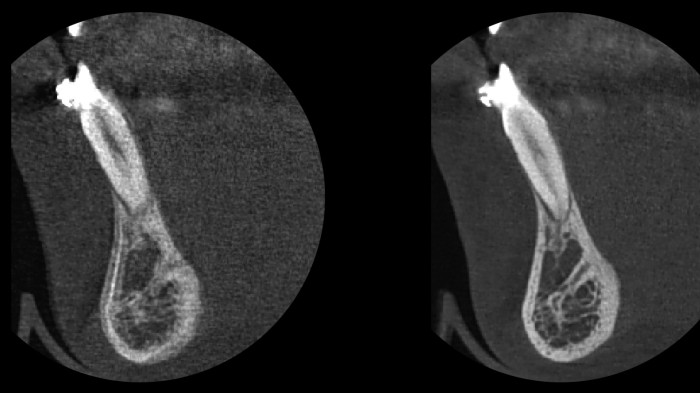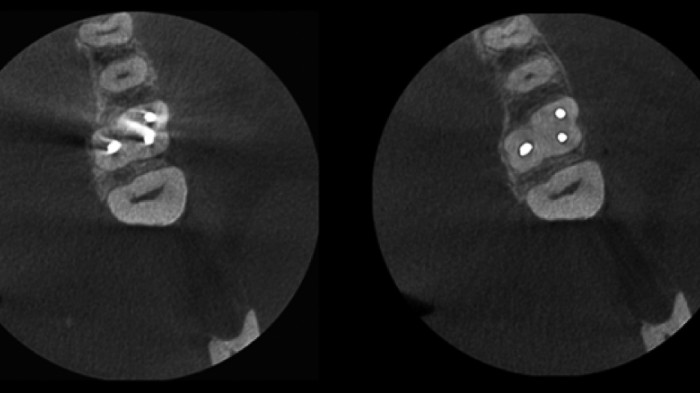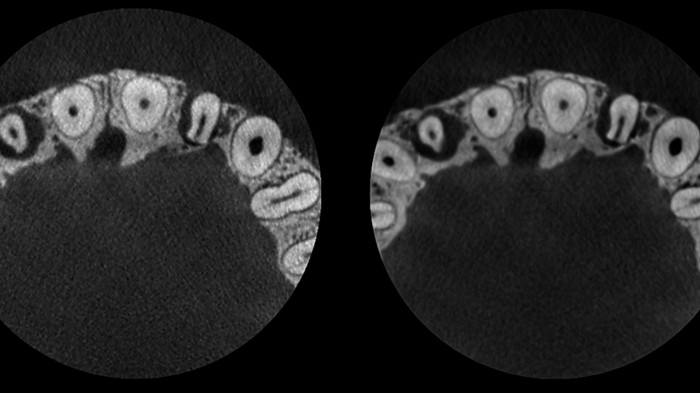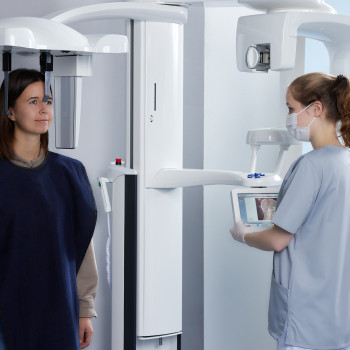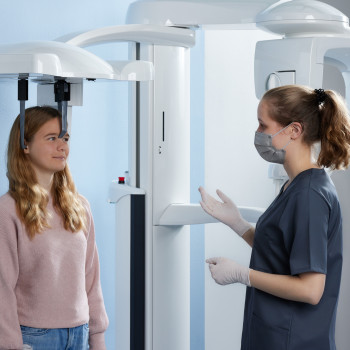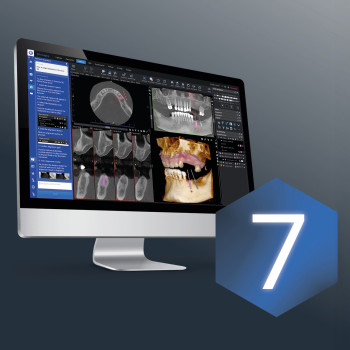- Free, automatic volume positioning
- Ease of use through intuitive operation, quick programme selection and preset exposure values and more
- 2D and 3D imaging with just one sensor
- Comfortable face-to-face patient positioning
- High image quality due to extremely small voxel sizes
- Scout images for the verification of volume positioning
- Ultra-low dose 3D imaging, ensuring an optimal balance of radiation dose and image quality
- Possibility of expansion on the cephalometric device
- 120kV tube voltage option for outstanding image quality
The KaVo ProXam 3DQ X-ray unit is a premium product in the KaVo imaging portfolio and combines all the qualities of extraoral KaVo ProXam 3D and 2D imaging with an even greater volume.
With additional, preconfigured programmes, the KaVo ProXam 3DQ offers even more diagnostic possibilities and a large number of ENT applications.
The existing 3DQ will be renamed 3DQ Pro from March 2025.
KaVo ProXam 3DQ - Teaser Video
KaVo ProXam 3D & 3DQ - Demo Video
ProXam 3DQ - Minimum radiation dose, maximum quality.
Diagnostically impressive 3D imaging at the highest level – that is the claim of the KaVo ProXam 3D X-ray portfolio. The two KaVo 3D X-ray units – KaVo ProXam 3D and KaVo ProXam 3DQ – offer modern, three-dimensional maxillofacial imaging at the highest level, and include numerous supplementary 2D programmes.
Based on extremely small voxel sizes, the KaVo 3D X-ray units generate high-resolution and detailed DVT images of compelling quality, even with a reduced radiation dose. The KaVo ProXam 3D series units, in combination with the all-in-one Romexis software, offer everything you need for an efficient, smart X-ray workflow.
That means a safe investment, and a process-optimised digital future.
Comfort at its finest - Simple, intuitive and safe.
Ease of use is a top priority.
A KaVo ProXam 3D X-ray unit can be controlled and operated in two ways: either via the swivelling touch display panel on the unit or remotely through the desktop software on a PC.
In addition to the cleverly designed graphic ProXam 3D | 3DQ interface, the touch display also impresses users thanks to simple and quick programme selection and preset exposure values for a wide variety of imaging types. The step-by-step instructions, which guide users through the entire X-ray workflow, are an added bonus.
2D and 3D imaging with just one sensor.
With the intelligent SmartPan™ imaging system, the 3D sensors can be used for all 2D images. This eliminates the need for a time-consuming sensor change between DVT and panorama imaging.
Scout images help verify volume positioning.
Before the actual 3D image, two 2D images can be created laterally and posterior/anteriorly. This helps prevent unnecessary 3D images and minimises the radiation dose for the patient.
Appropriate recording modes for a variety of indications.
Depending on the clinical situation, the tailor-made recording modes of both KaVo ProXam 3D units provide accurate presets, enabling the best possible image quality with the lowest possible radiation dose.
- In the Ultra Low Dose mode, each X-ray image is created with the minimum radiation dose possible. Ideal for paedodontic dentistry, orthodontics and sinus applications (voxel size 400 or 600 µm).
- The normal standard mode is the choice for all standard X-ray examinations (voxel size 200 µm).
- The High Definition or HD mode is ideal for recording extremely fine structures such as fractures (voxel size 150 µm).
- The HiRes (High Resolution) mode provides particularly high-resolution images (voxel size 100 µm).
- The endodontics mode offers the maximum resolution (voxel size 75 µm).
Suitable for all patients.
The open architecture of the KaVo ProXam 3D X-ray units and their spacious, vertical range of motion make it easy to position children, very tall patients, or wheelchair users. The robot-controlled SCARA (Selectively Compliant Articulated Robot Arm) technology with 3-joint arm enables high-precision movements for anatomically correct image geometry.
This allows the C-arm to be fully extended, ensuring easy entry from the side. The open face-to-face positioning gives anxious patients, for example, the sense of security they need.
For better visualisation and to support patient positioning, this is shown on the touch display. The integrated quadruple laser system is available for correct patient placement.
Suitable for the KaVo 3D X-ray units:
The KaVo PHYSIO chair with stepless height adjustment and lockable castors, resulting in precise and stable patient positioning with every X-ray.
- The patented SCARA (Selectively Compliant Articulated Robot Arm) technology ensures anatomically correct image geometry.
- Easy-to-use touch display with a variety of practical presettings.
- Fully integrated into the Romexis all-in-one software for additional time savings in the digital process.
- More flexibility with the ability to expand to the cephalometric unit.
- Autofocus adjusts the focus layer for optimal panoramic shots.
KaVo ProFace
KaVo ProFace offers an innovative way to capture a realistic 3D facial photo and a CBCT image in a single scan.
Alternatively, it can be used simply to create a 3D facial photo – without exposing the patient to radiation.
This integrated technology is compatible with all KaVo 3D imaging units.
Same image quality, less radiation.
With the Ultra Low Dose imaging protocol, the KaVo ProXam 3D units offer high-quality DVT images with a radiation dose that is lower than with conventional 2D panoramic images.
The effective radiation dose per patient can be reduced by an average of 77% in Ultra Low Dose mode – without any loss of image quality (Study of Orthodontic Diagnostic FOVs Using Low Dose CBCT protocol (Ludlow, John Barrett and Koivisto, Juha).
Based on special 3D algorithms, the Ultra Low Dose mode can be used with all voxel sizes and in all programmes – up to and including Endo mode.
For a variety of indications, exposures in Ultra Low Dose mode are particularly suited for the following indications:
- Implant planning
- Postoperative follow-up after maxillofacial interventions
- Examination of the airways and sinuses
- In orthodontics:
- for determination of the apical bone supply
- for locating non-erupted or impacted teeth
- for defining reference points for cephalometric analysis
CALM mode: For automatic correction of motion artefacts.
- Iterative algorithm for automatic correction of motion artefacts.
- Ideal for longer scan times and imaging of restless patients, especially children or older patients.
- Minimal time and radiation dose through the elimination of additional repeat exposures.
ARA mode: Outstanding image results without metal artefacts.
- Reliable algorithm for artefact-free recordings
- Automatically removes shadows and strips that can be caused by metal restorations or root fillings.
- Scientifically proven, tried and tested in practice
AINO mode: For reliable noise reduction.
- Noise-free images without any loss of valuable details
- Enables the lowest dose of radiation
- Optimum image quality through the use of small voxel sizes, for example in endodontics mode
- When using Ultra Low Dose mode, AINO is enabled by default.
| Imaging modules | |
|---|---|
| 3D Imaging | |
| KaVo ProXam 3D provides high-resolution volumetric 3D images of the lower and upper jaw as well as the entire dental area. | 
|
| 3D endodontic imaging mode. | 
|
| KaVo ProFace enables 3D photo capture in the same session with the X-ray image or separately. | 
|
| Model scan programs: Special programs create very precise 3D images of impressions and plaster casts. | 
|
| 2D Imaging | |
| The SmartPan system uses the same 3D Sensor for 2D panoramic images. Also includes MultiView SmartPan, which creates nine panoramic images at different angles. MultiView SmartPan can be used in the panorama programmes. | 
|
The Auto Focus function automatically positions the focal layer based on a low-dose Scout image of the centre of the patient's incisors. It uses points of reference in the patient's anatomy to calculate placement, allowing for error-free patient positioning. Available: basic panorama programmes, horizontal and vertical segmentation, bitewing panorama programme. | 
|
| Ceph for ceph images. | 
|
| The 2D view with 3D programme provides 2D images in the diagnostic quality of a 3D sensor. | 
|
| Mode | Endodontics(optional) | High Resolution | High Definition (HD) | Normal | Low |
|---|---|---|---|---|---|
| Voxel size in µm | 75 | 100 | 150 | 200/400 | 400/600* |
* 600 only applicable for ProXam 3DQ Pro
| Programme | Volume (child height), cm | Example | Mode/voxel |
|---|---|---|---|
| Tooth | Ø 4 x 5 (Ø 3,4 x 4,2) | 
| Endo 75 μm HR 100 μm HD 150 μm N 200 μm d L 400 μm |
| Ø4 x 8 (Ø 3,4 x 6,8) | HD 150 μm N 200 μm d L 400 μm | ||
| Teeth | Ø 8 x 5 (Ø 6,8 x 4,2) Ø 8 x 8 Ø 6,8 x 6,8) Ø 10 x 6 (Ø 8,5 x 5,0) Ø 10 x 10 (Ø 8,5 x 8,5) | 
| HD 150 μm N 200 μm d L 400 μm |
| Jaw | Ø 16 x 6 (Ø 16 x 6) Ø 16 x 10 (Ø 16 x 10) Ø 19 x 6 (Ø 19 x 6) Ø 19 x 10 (Ø 19 x 10) | 
| HD 200 μm N 400 μm d L 600 μm |
| Face | Ø 19 x 9 (Ø 19 x 9) einzeln Ø 19 x 15 ( Ø19 x 15) stitched | 
| HD 200 μm N 400 μm d L 600 μm |
Endo = Endodontics, HR = High Resolution, HD = High Definition, N = Normal, L = Low, d = Default
| Programme | Volume (child height), cm | Beispiel | Mode/voxel |
|---|---|---|---|
| Sinus | Ø 10 x 8 ** only available for ProXam 3DQ Pro | 
| N Ø 100 200 μm Ø 200 400 μm d L Ø 100 400 μm Ø 200 600 μm |
| Nose | Ø 8 x 8 (Ø 6,8 x 6,8) | N 200 μm d | |
| Middle ear | Ø 4×5 (Ø 3,4×4,2) | Endo 75 μm HR 100 μm HD 150 μm d N 200 μm | |
| Ø 8 x 8 (Ø 6,8 x 6,8) | HD 150 μm d N 200 μm L 400 μm | ||
| Middle ear pair | Ø 4 x 5 (Ø 3,4 x 4,2) Ø 8 x 8 (Ø 6,8 x 6,8) | N 200 μm d L 400 μm | |
| Temporal bone | Ø 8 x 8 (Ø 6,8 x 6,8) | 
| HD 150 μm d N 200 μm |
| Temporal bone pair | Ø 8 x 8 (Ø 6,8 x 6,8) | N 200 μm d L 400 μm | |
| Cervical spine | Ø 8 x 8 (Ø6,8 x 6,8) | 
| N 200 μm d L 400 μm |
| Airways | Ø 8 x 8 (Ø6,8 x 6,8) | 
| N 200 μm d L 400 μm |
Endo = Endodontics, HR = High Resolution, HD = High Definition, N = Normal, L = Low, d = Default
| ProXam 3DQ | |
|---|---|
| Classification | Medical Device Directive 93/42/EEC (Class IIb) RoHS: 2011/65/EU IEC 60601-1: Class I, Type B CISPR 11: Class B IP Classification: IP20 |
| Generator | Constant potential, microprocessor controlled, resonant mode, operating frequency 80-160 kHz, Power factor corrector, meets the IEC 60601-2-7 standard |
| X-ray tube | D-054SB, D-059SBR or SXR 130-10-0.5 SC |
| Focal spot size | 0,5 0.5 x 0.5 mm, according to IEC 60336 |
| Total filtering | min. 2,5 mm Al + 0,5 mm Cu |
| Anode voltage | 2D: 60 – 84 kV Ceph: 60–84 kV 3D: 60 – 90 kV or 60 - 120 kV |
| Anode current | 2D: 1 – 16 mA Ceph: 1-16 mA 3D: 1 – 14 mA (Steps with the R20 series: 1, 1.1, 1.25, 1.4, 1.6, 1.8, 2.0, 2.2, 2.5, 2.8, 3.2, 3.6, 4.0, 4.5, 5.0, 5.6, 6.3, 7.1, 8.0, 9.0, 10.0, 11.0, 12.5, 14.0, 16.0) |
| Exposure time | 2D: 2,7 -16 s SmartPan: 2,5 – 15,6 s 3D: 3 – 36 s |
| Scan time | 14 – 37 s |
| Scan angle | 200° / 360° |
| SID | 2D: 574 mm Ceph: 1700 mm 3D / SmartPan 90 kV: 600 mm |
| Focus-skin distance | min. 150 mm |
| Enlargement | SmartPan: 1,4 3D: 1,8 / 1,43 / 1,42 / 1,40 / 1,38 |
| Panorama image size | SmartPan: 190 x 100 mm |
| Line voltage | 100 – 240 V~ ±10%, 50 or 60 Hz Power Factor Corrector |
| Line current | 8 – 15 A |
| ProXam 3DQ | |
|---|---|
| 3D | |
| Pixel size | 127 μm |
| Active surface | 15 x 15 cm |
| Sensor | |
| CCD pixel size | 48 μm |
| Image pixel size | 48/96/144 μm (adjustable) |
| CCD active surface | 6 x 146 mm, 2D 6 x 292 mm, Ceph |
| Ceph image size | 300 x 270 mm |
| Image sizes | SmartPan panorama, Adult: 14.6 x 33.0 cm, anatomical size 10.4 x 23.6 cm SmartPan panorama, Child: 12.7 x 28.7 cm, anatomical size 9.0 x 20.5 cm Ceph: 18 x 18 cm - 30 x 27 cm, anatomical size 15.9 x 15.9 cm - 26.5 x 23.9 cm |
The 3D reconstruction computer is a maintenance-free, high-performance Linux-based computer that acquires and reconstructs images from an imaging unit. This automatic reconstruction converts the original image data into the 3D volume, which is then transferred to the workstation (Romexis) and to the Romexis server for storage. The 3D reconstruction computer is included in all deliveries of the KaVo ProXam 3D units.
The following figures show the dimensions of the X-ray unit and the minimum space required (grey area) for smooth operation.
| The maximum height is adjustable | |
|---|---|
| Weight | 141 kg (3D unit) 26 kg (Ceph) |
| Chin rest level | 97 – 171 cm |
| Ceph ear pad height | 97 – 179 cm |
ProXam 3D, 3DQ & 3DQ Pro in comparison:
| KaVo ProXam 3DQ Pro | KaVo ProXam 3DQ | KaVo ProXam 3D | |
|---|---|---|---|
| Voxel size | 75 / 100 / 150 / 200 / 400 / 600 μm | 75 / 100 / 150 / 200 / 400 μm | 75 / 100 / 150 / 200 / 400 μm |
| Maximum volume single scan | Ø20 x 10 cm | Ø20 x 10 cm | Ø8 x 8 cm |
| Extended volume single scan | Ø11 x 8 cm (optional) | ||
| Maximum volume multiple scans | Ø20 x 17 cm | ||
| 3D dental programmes | | | |
| ULD, ARA, AINO | | | |
| 2D Panorama Imaging | | | |
| 3D Endodontics mode | (optional) | (optional) | (optional) |
| 3D ENT programs | (optional) | (optional) | |
| 3D Model scan | (optional) | (optional) | (optional) |
| Correction of movement artifacts with CALM® | (optional) | (optional) | (optional) |
| Cephalometric option, scanning | (optional) | (optional) | (optional) |
| Cephalometric option, one-shot (ProCeph) | (optional) | (optional) | (optional) |
| 3D face recording (KaVo ProFace) | (optional) | (optional) | (optional) |
| Tube voltage option 120kV | (optional) | (optional) |
Accessories:
3D Quart Test Phantom Set
Mat. No.: 2.023.5072
2D Quart Test Phantom Set
Mat. No.: 2.023.4050
Wall switch EU
Mat. No.: 2.023.1051
Manual x-ray support
Mat. No.: 2.023.4052
Additional wall mount bracket
For two-point wall mount
Mat. No.: 2.023.4053
